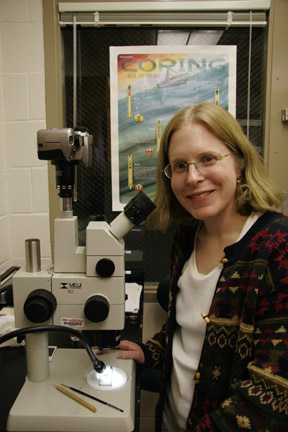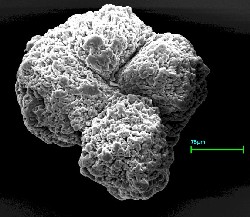Samples from Arctic Sea Floor May Rock Global Climate Theories
NewsBy Eric Gorton

Sitting there in glass vials on a laboratory shelf, the specimens look rather ordinary—no different, in fact, than the sand that takes you six months to clean out of your car after a trip to the beach.
The vials' content is certainly more interesting under a microscope, where every grain has its own color, its own texture, its own size. Yes, sand really is a bunch of tiny rocks.
Ah, but there's so much more to sand than that, especially the sand sitting on the shelves in the lab of JMU geology Associate Professor Kristen St. John. These samples came from the Arctic sea floor, where they'd been for up to 46 million years.
"That's like a time capsule of what's been happening in the Arctic, and no one had recovered it before," said St. John, who is part of an international team of scientists studying sediment recovered during an Integrated Ocean Drilling Program expedition in August 2004.
One goal of the expedition, which dug deeper into time in sampling the Arctic than any before it, was to confirm or debunk a theory that the central Arctic's Lomonosov Ridge was once part of Russia. To find the answer, core samples had to be taken from the harder bedrock buried beneath millions of years of sediment buildup, then compared to rock on land. More than 400 meters of sediment was recovered from four holes, St. John said, revealing a geologic time line from the present—the mud and sand at the top—to more than 56 million years ago—the sand at the bottom of the deepest holes.
St. John, who could not participate in the coring expedition due to the birth of her youngest child just months before, got her first look at the samples in Bremen, Germany, in November 2004 when the cores were opened for the first time. One of four sedimentologists on the international team, her job was to describe in writing her observations of the sediment: its composition, its texture, any color changes and any anomalies, such as larger pebbles occasionally embedded in finer sand.
While describing the cores centimeter by centimeter can be a bit tedious, the task was highly important. "It's like being a scribe to the rest of the scientific community that didn't get to see it with their own eyes," she said.
The close inspection also turned out to be very rewarding. So far, St. John says, there's evidence that the Arctic may have froze over about 40 million years ago, nearly the same time, geologically speaking, as the Antarctic, which generally is thought to have frozen tens of millions of years ahead of the Arctic as the earth's climate shifted from the "greenhouse world" of the dinosaur age to the "ice house world" that exists today.
"We've got lots of records for the Cenozoic (era) for pretty much every other latitude, but nothing spanning that for the Arctic. So that's just a big—what's the story? So we're still trying to figure out what some of that story is, but, even just from what we did in Bremen, we could see some things right away that have major climatic implications," St. John said.
The Proof Is In The Pebbles

Under the microscope, the sand grains take on their own characteristics and reveal a history of the Arctic.
The pebbles found amidst the sediment offer the most compelling evidence that the Arctic froze much earlier than previously thought, St. John said. The pebbles are consistent with rock found in Russia hundreds of miles away and the only way they could have reached the central Arctic was to be brought there by ice.
"Every now and then, we would see another pebble in the core. And it wasn't just going back to seven million years ago (the time most commonly associated with the freezing of the Arctic). We were seeing pebbles all the way into the middle Eocene (40 million years ago), all the way to the time that the long-term record for Antarctica showed that there was ice there.
"What's the significance of one pebble? Well, the significance is that those pebbles, to get to the central arctic, to get to a ridge, a high spot on the sea floor in the central arctic, there's only so many ways it can get there. ... You can't say, ‘Well, it was just brought there from a big storm and rivers were churned up and it was flowing out there. That will make it into the deep basin, at the base of the continental slope perhaps. ... It can't be wind blown. These are pebbles that are, oh, I don't know, a couple centimeters in diameter, they're not going to be windblown that far from land.
"You start eliminating all of the possibilities that you can think of and it pretty much comes down to: It was brought by ice. Because when ice forms on land, it freezes whatever it's touching into it, like a fly in an ice cube. So it's freezing pebbles, big ones, all different sizes of sediment and it's bringing it out there."
And as the floating ice melted, it dropped its catch to the sea floor.
"The fact that we were seeing pebbles back this far, that was really neat, that was just so exciting," St. John said. "There's always going to be naysayers and they're going to say, ‘well, maybe it was just some log or something, or a bird or whatever. But when you see enough of them, there's too many, and you start to see a pattern."
Even if the findings prove the Arctic froze much sooner than previously believed, St. John says the research will not fuel current debates on the effects of global warming. Long before human existence, climate cycles occurred, she said. Humans, however, have affected the earth's climate by burning fossil fuels, cutting forests, farming and in other ways.
"I don't think any credible scientist would argue that we haven't had an influence on climate," she said.
How much of an effect, however, is up for debate. Have humans significantly changed existing climate cycles? That's what climate modelers are trying to determine, she said.
As for St. John, her main goal is satisfying her own curiosity about the earth's mysteries and sharing what she learns with others.
"The earth is just this big puzzle and trying to contribute another piece to the puzzle, to try to understand how the earth works, how it worked in the past is very satisfying and very interesting," she said. "The fun part is making a contribution that other people can then build upon.
"What I do in a laboratory is pretty straightforward—sitting at a microscope, looking at sand grains—but, it opens up this whole world that people don't even really ever think about. You know, you walk on the beach on grains of sand and it's just where you put your towel. But those are clues to something that happened before. You just need to learn how to read what the clues are."
St. John and her students are busy now studying the layers of Arctic sand and verifying the time line it appears to have created.

A grain of sand viewed through a scanning electron microscope.
Seniors Brendan Quirk, Kirsten Mullen and Michelle Summa have been involved with a variety of tasks, such as sorting the sand by grain size, weighing it, photographing it through microscopes and logging their findings. They present their research at the annual Geology and Environmental Sciences Senior Symposium April 28 in Memorial Hall, the former Harrisonburg High School.
In May, St. John travels to Sicily to report on what she and her students have learned and also to hear from others on the international team who are researching other aspects of the cores and bedrock samples, which did prove to be the same type of rock as that found in Russia.
The results of the initial finding from the work in Bremen have been submitted to the journal "Nature" for review.

